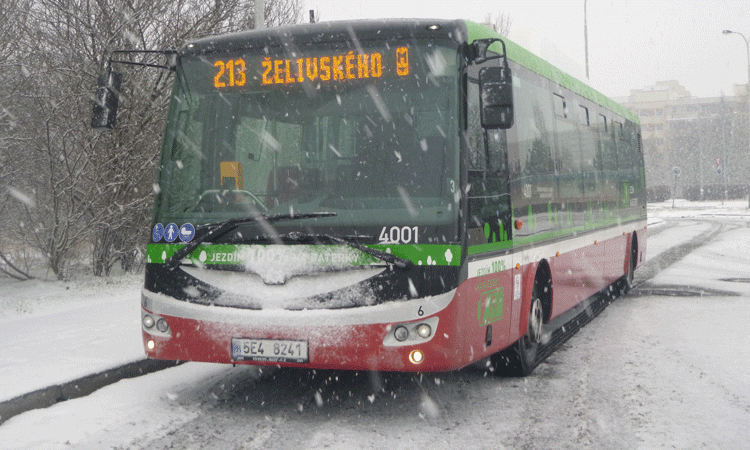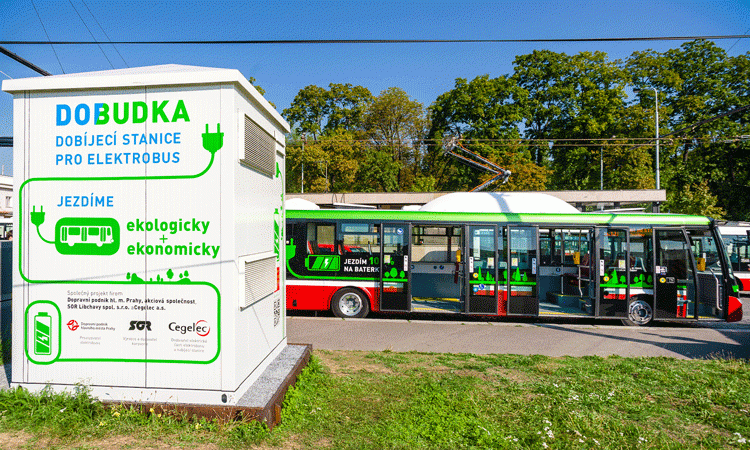Battery buses: Prague’s electrifying future
- Like
- Digg
- Del
- Tumblr
- VKontakte
- Buffer
- Love This
- Odnoklassniki
- Meneame
- Blogger
- Amazon
- Yahoo Mail
- Gmail
- AOL
- Newsvine
- HackerNews
- Evernote
- MySpace
- Mail.ru
- Viadeo
- Line
- Comments
- Yummly
- SMS
- Viber
- Telegram
- Subscribe
- Skype
- Facebook Messenger
- Kakao
- LiveJournal
- Yammer
- Edgar
- Fintel
- Mix
- Instapaper
- Copy Link
Posted: 11 October 2017 | Jan Barchanek (DPP) | No comments yet
Jan Barchanek, Deputy Manager, Bus Operation Unit, Prague Public Transit Company (DPP), explains how electrification has become Prague’s most economically viable option for environmentally cleaner bus routes.


The DPP is continuously working to reduce bus emissions, and a large part of this work is testing alternative technologies and fuels. At various points, we have tested LPG and CNG, as well as hybrid vehicles. For several years, some buses operated with diesel emulsion (GECAM) and 100% bio-diesel.
However, due to limited external financial sources and subsidies, we had to consider economic aspects as well as environmental benefits. With this in mind, bus electrification was selected as the most plausible method to further strategic development as, despite its initially high costs, it enables zero local emissions. There’s even potential for the economic balance of e-bus operation to be improved by using the internal synergetic effects of other DPP operations, for example its underground or tram supply network.
The testing phase
The DPP has been testing e-buses with various charging systems since 2011, and these tests have proven valuable in providing significant new information and experiences; existing vehicles and technologies could not meet the operational requirements of diesel buses.
Negotiations with different contractors have resulted in the ‘Battery Bus for Prague Pilot Project’, which has been joined by SOR Libchavy s.r.o., a vehicle manufacturer, and Cegelec a.s., a supplier of electric equipment and charging technology.
The project supplies e-buses with opportunity charging from the city’s tram supply network using a short section of a two-pole (trolleybus) trolley. To consider battery buses a viable option, they need to be able to operate for an entire day, which would typically see them cover 250km. They also need to be a zero-emission solution that can still provide electrical heating and air-conditioning.


The DPP is preparing to purchase 14 e-buses with similar two-pole charging technology after positive testing so far
To meet these requirements, the manufacturer offered the EBN 11, a bus that is 11.1m long, with engine power of 120kW and a battery capacity of 172kWh. Use of the two-pole charging system, while keeping the vehicle’s construction simple (single isolation), was enabled by the installation of a stationary galvanic separator – this secures system safety, and transforms the variable tram section voltage (400-1000V DC) into a safe, stable charging voltage for the e-bus (750V DC).
Vehicle and charging infrastructure tests started in June 2015, and since September 2015 have seen the battery bus used in common operation with passengers on bus lines 163, 188 and 213. As of 31 August 2017, a total distance of 144,000km has been covered by the battery buses, with daily distances amounting to 260-280km on weekdays, and up to 340km at weekends. The project is still ongoing, and now uses a new generation vehicle type, SOR NS12.
Two-pole technology testing
The frequently used multiple-pole charging systems enable a complex ‘turnkey’ solution even for operators with no experience of electric traction. The two-pole solution used in Prague is more difficult: it requires galvanic separation, or vehicle double isolation, but it offers significant simplification of the charging interface (trolley vs pantograph) and compatibility with the operation of (battery) trolleybuses. The construction method is easy, and it can be moved when needed, such as during closures. Furthermore, there is good leeway for stopping in the charging place – other systems require precision to the centimetre – and the option of charging more vehicles at one trolley. Long-term tests have shown the real plausibility of two-pole charging systems, and have also enabled a practical assessment of its limits (maximum charging performance, the influence of different climates, etc.).
Economically effective e-bus operation needs to cover the ancillary expenses of the vehicle and charging infrastructure. Operational tests have shown that even in winter, when power consumption is increased due to electrical heating, the energy costs can be 50% lower compared to diesel operations, and during the summer, this figure rises to 70%. The common purchase of electricity, use of existing tram charging infrastructure, and use of ‘free’ energy from tram recuperation, alongside convenient selection of lines and circuits, means that the total economic balance of the project is comparable to diesel bus operations. As a result, the project was implemented without EU funds or other subsidies, unlike most similar projects in the Czech Republic and abroad.
Electrification of line 207
Based on the positive test results, the next step is full electrification of bus line 207 – the route that connects Žižkov with the city centre. The DPP is preparing to purchase 14 e-buses with similar two-pole charging technology. Opportunity charging will take place at Ohrada terminal, using the tram converter station Krejcárek, while the Vršovice depot will serve as the night battery changing and balancing point, as the tram (ex-trolley) converter station is located there.
During the pilot project, night charging was only possible via cable, but in Vršovice, 14 fully equipped charging trolley points will be built. This system will optimise the charging power and time in accordance with both the battery and the required time of morning departure. The expected economic balance when compared to a diesel operation is slightly worse on this line owing to the lower operational speed and the full provision of all shifts, including those that are less effective. Nevertheless, the non-financial advantages – a decrease in emissions and noise – are very important for the city centre. The operation is set to begin in the second half of 2018, and before then, the charging infrastructure must be built and the e-buses tendered.
In-Motion Charging project
By the end of 2017, we are aiming to launch another pilot project, ‘E-Bus with In-Motion Charging’. This project is being run for the busiest lines (articulated buses, long daily routes and hilly terrain) where opportunity charging may prove to be technically or economically challenging. It will test the possibilities of in-motion charging, so that the positive effects of the zero-emission transport can also be felt on Prague’s busiest bus routes.
For in-motion charging tests, approximately 1km of trolleybus trolley is being prepared in Prosecká street. In the first stage, the operation will be tested from Palmovka to Letňany (a distance of 10km), where in addition, opportunity charging will also be performed at Palmovka terminal. The main difference is that the buses will be driving under trolley for only 10-15% of line length, compared to the usual 70-90%). The project should verify the technical, operational and legislative plausibility of the solution, but it is hoped it will also find an ideal combination of vehicle and infrastructure parameters (battery capacity, ratio of driving under trolley, length of charging breaks for opportunity charging, etc.).
The development of e-mobility in bus operations is a key part of Prague’s long-term emission reducing strategy. The results and experience gained so far show that success depends on close cooperation and the sharing of knowledge and experience throughout the DPP. Where other public transport operators might think that e-bus operations need to be built from the ground up, the DPP is proving that synergy between different modes of transport offers an undisputed advantage.


Related topics
Alternative Power, Fleet Management & Maintenance
Issue
Issue 1 2017
Related modes
Bus & Coach







